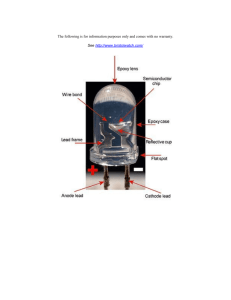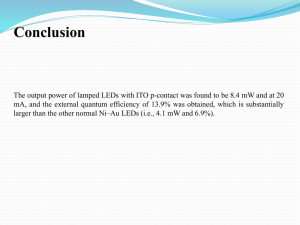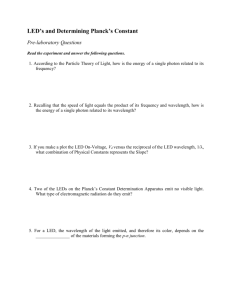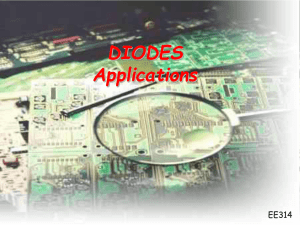UV – LED
advertisement
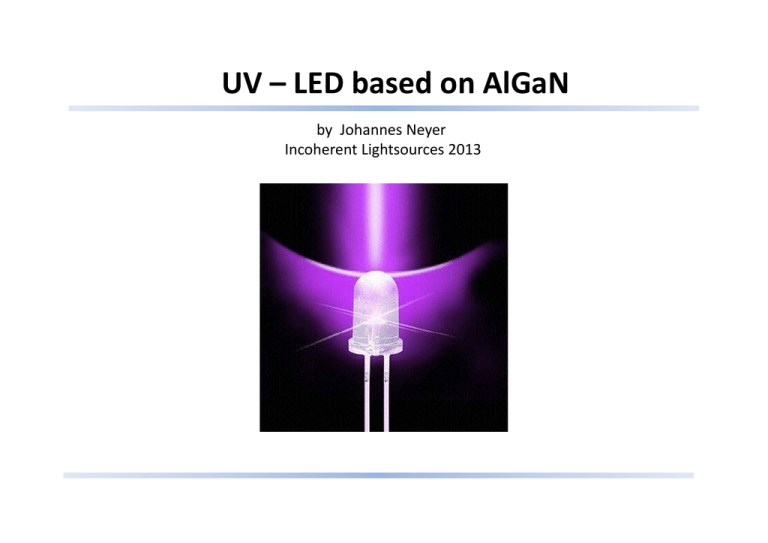
UV – LED based UV LED based on AlGaN on AlGaN by Johannes Neyer Incoherent Lightsources 2013 Content History of Light Emitting Diodes (LEDs) Working principle Working principle Types of LEDs UV‐LEDs AlGaN LED Comparison to Hg low vapour pressure lamp Applications UV – LED Incoherent Lightsources 2013 History of Light Emitting Diodes y g g 1907 ‐ The British experimenter J.H. Round of Marconi Labs discovered, that some inorganic materials start to glow if a current is applied. Today known as electroluminescence. 1927 ‐ The Russian physicist Oleg Vladimirovich Losev rediscovered Rounds phenomenon and did further research until 1942. He reported on phenomenon and did further research until 1942. He reported on the first LED, but no practical use was made of it. 1955 ‐ 1955 ‐ Rubin Braunstein Rubin Braunstein observed infrared light emission generated by observed infrared light emission generated by simple semiconductor structures using GaAs, GaSb, InP and SiGe. 1961 1961 ‐ Robert Biard R b t Bi d and Gary Pittman of Texas Instruments found out that dG Pitt fT I t t f d t th t GaAs emitts infrared light if a electrical current is applied. They received a patent for the infrared LED. UV – LED Incoherent Lightsources 2013 History of Light Emitting Diodes y g g 1962 ‐ Nick Holonyak, Jr., while working at General Electric Company developed the first red LED as is seen as the "father of the light‐ emitting diode“. 1972 ‐ M. George Craford invented the first yellow LED and improved the brightness of red and red‐orange brightness of red and red orange LEDs by a factor of ten. LEDs by a factor of ten. 1994 ‐ The first high‐brightness blue LED was demonstrated by Shuji Nakamura of Nichia Corporation and was based on Nichia Corporation and was based on InGaN. InGaN 1995 ‐ First white LED is presented, which emits white light by light conversation from UV to broadband spectra using phosphorus. ti f UV t b db d t i h h UV – LED Incoherent Lightsources 2013 Working principle gp p b basic material: doped semiconductor i t i l d d i d t with a p‐n junction The applied current flows, like in other diodes, easily from p‐side to n‐side In the junction area the charge carriers, electrons and holes, combine and drop down to a lower energy level by emitting a photon gy y g p The wavelength of the photons corresponds to the energy of the band gap band gap UV – LED Incoherent Lightsources 2013 Types of LEDs yp schematic setting: UV – LED real setting: Incoherent Lightsources 2013 Types of LEDs yp Various types of LED shapes: UV – LED Incoherent Lightsources 2013 Types of LEDs yp Color Wavelength [nm] Voltage drop [ΔV] Semiconductor material Gallium arsenide (GaAs) Aluminium gallium arsenide (AlGaAs) Infrared λ > 760 ΔV < 1.63 Red 610 < λ < 760 1.63 < ΔV < 2.03 Aluminium gallium arsenide (AlGaAs) Gallium arsenide phosphide (GaAsP) Aluminium gallium indium phosphide (AlGaInP) Gallium(III) phosphide (GaP) Orange 590 < λ < 610 2.03 < ΔV < 2.10 Gallium arsenide phosphide (GaAsP) Aluminium gallium indium phosphide (AlGaInP) Gallium(III) phosphide (GaP) Yellow 570 < λ < 590 2.10 < ΔV < 2.18 Gallium arsenide phosphide (GaAsP) Aluminium gallium indium phosphide (AlGaInP) Gallium(III) phosphide (GaP) Traditional green: Gallium(III) phosphide (GaP) Aluminium gallium indium phosphide (AlGaInP) Aluminium gallium phosphide (AlGaP) Pure green: Pure green: Indium gallium nitride (InGaN) / Gallium(III) nitride (GaN) Green 500 < λ < 570 1.9 < ΔV < 4.0 Blue 450 < λ < 500 2.48 < ΔV < 3.7 Zinc selenide (ZnSe) Indium gallium nitride (InGaN) Silicon carbide (SiC) as substrate Silicon (Si) as substrate—under development Violet 400 < λ < 450 2.76 < ΔV < 4.0 Indium gallium nitride (InGaN) Purple multiple types 2.48 < ΔV < 3.7 Dual blue/red LEDs, blue with red phosphor, or white with purple plastic Ultraviolet λ < 400 3.1 < ΔV < 4.4 Diamond (235 nm) Boron nitride (215 nm) Aluminium nitride (AlN) (210 nm) Aluminium gallium nitride (AlGaN) ( ) Aluminium gallium indium nitride (AlGaInN)—down to 210 nm Pink multiple types ΔV ~ 3.3 Blue with one or two phosphor layers: yellow with red, orange or pink phosphor added afterwards, or white with pink pigment or dye. White Broad spectrum ΔV = 3.5 Blue/UV diode with yellow phosphor UV – LED Incoherent Lightsources 2013 UV‐LEDs Ultraviolet light: Wavelength: λ g < 400 nm Band gap energy: 3,1 – 4,4 eV Materials: ‐ Diamond (235 nm) ‐ Boron nitride (215 nm) ‐ Aluminium nitride (AlN) (210 nm) Spectrum for an AlGaN‐based UV LED ‐ Aluminium gallium nitride (AlGaN) (340 nm) ‐ Aluminium gallium indium nitride (AlGaInN)—down to 210 nm UV – LED Incoherent Lightsources 2013 AlGaN‐LED Schematic structure order UV – LED Wavelength dependency on material composition Incoherent Lightsources 2013 Comparison p to low p pressure Hg‐Lamp g p AlGaN UV‐LED: Hg low pressure Lamp*: Efficiency: y 5‐15% Efficiency: y 40% Lifetime: > 15.000 h Lifetime: 16.000 h Output Power: Output Power: 30 mW (100 mA) 30 mW (100 mA) Output Power: Output Power: 4 W (100mA) 4 W (100mA) no risks of environmental pollution by UV‐LEDs LEDs have no time delay by warming up, ‐> good for applications with fast on/off switches LEDs have no wide spectral power distribution LEDs have no dropping in UV output over lifetime * standart quartz lamp * standart quartz lamp UV – LED Incoherent Lightsources 2013 Applications pp Adhesive/lacquers hardening Quality control Sterilisation / Disinfection (liquids, air) / ( q , ) Medicine ( light therapy) Microscopy (Fluorescence) ( ) Light conversion (UV on various types of phosphorus) UV – LED Incoherent Lightsources 2013 Thank yyou for yyour attention! Sources: Wikipedia: Light‐emitting Diode (english) http://en.wikipedia.org/wiki/Led#Ultraviolet_and_blue_LEDs UV LEDs ramp up the quiet side of the LED market htt //l d http://ledsmagazine.com/features/9/2/5 i /f t /9/2/5 AlGaN deep ultraviolet LEDs on bulk AlN substrates (Zaiyuan Ren1, Q. Sun1, S.‐Y. Kwon1, J. Han*,1, K. Davitt2, Y. K. Song2, A. V. Nurmikko2,W. Liu3, J. Smart 3, and L. Schowalter 3) Efficiency Increase For Deep UV LEDs http://www compoundsemiconductor net/csc/features‐details/19735467/Efficiency‐increase‐for‐deep‐UV‐LED http://www.compoundsemiconductor.net/csc/features details/19735467/Efficiency increase for deep UV LED.html html HG low pressure lamps data http://www.light‐sources.com/ UV – LED Incoherent Lightsources 2013
